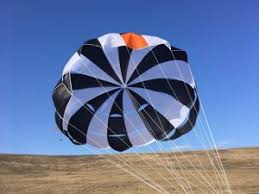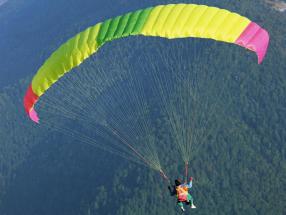Beginner Tips – Low U-Turn (part 2)
 Now consider the pitch angle of the dome, which is often confused with the angle of attack. This is the pitch angle that is set by mutually adjusting the length of the lines. The canopy pilot can also change it in flight by pulling the front or rear free ends of the suspension system. Pulling the front free ends changes this pitch angle, but not the angle of attack. With a larger negative pitch angle, the dome will gain a greater vertical speed, but the direction of the relative flow remains practically unchanged, with the exception of the moments when this maneuver begins and leaves it. For most domes, the sling adjustment sets the pitch angle at which the dome moves 3 meters forward when reduced by one meter – they say that the aerodynamic quality of the dome is 3: 1. A smaller negative pitch angle will improve aerodynamic quality and allow you to cover a greater horizontal distance, however, the price for this is lower pressure inside the dome, which makes the profile of such a wing less stable in turbulence. In turn, a larger negative angle increases the rate of descent and “pressurization” of the dome, but reduces the ability to plan, and sometimes leads to the loss of a “pillow”.
Now consider the pitch angle of the dome, which is often confused with the angle of attack. This is the pitch angle that is set by mutually adjusting the length of the lines. The canopy pilot can also change it in flight by pulling the front or rear free ends of the suspension system. Pulling the front free ends changes this pitch angle, but not the angle of attack. With a larger negative pitch angle, the dome will gain a greater vertical speed, but the direction of the relative flow remains practically unchanged, with the exception of the moments when this maneuver begins and leaves it. For most domes, the sling adjustment sets the pitch angle at which the dome moves 3 meters forward when reduced by one meter – they say that the aerodynamic quality of the dome is 3: 1. A smaller negative pitch angle will improve aerodynamic quality and allow you to cover a greater horizontal distance, however, the price for this is lower pressure inside the dome, which makes the profile of such a wing less stable in turbulence. In turn, a larger negative angle increases the rate of descent and “pressurization” of the dome, but reduces the ability to plan, and sometimes leads to the loss of a “pillow”.
The presence of a pendulum load suspended under the wing is an important feature of the parachute wing, which is absent in other aircraft. Almost all the cargo carried by the dome is suspended at a considerable distance from the wing. It is this feature that leads to the peculiar flight characteristics of the canopy in a U-turn. When you enter the dome into a U-turn, the pilot’s body continues to move in a straight line until the moment when the slings turn it to a new course. If the rotation continues, the centrifugal force keeps the skydiver’s body on an arcuate trajectory. After stopping the turn, the “suspension” returns back under the dome. It is at the time of the return of the weight of the parachutist under the canopy that the maximum speed develops. This occurs as a result of an increase in the specific load on the wing, as well as an additional set of vertical speed.
The term “wing load” is often used to describe the weight supported in the air by the wing. In the U.S., the canopy load is calculated by dividing the total weight of the paratrooper at the time of separation (which is equal to his own weight plus the weight of all equipment) in pounds (1 pound = 0.453 kg) by the area of the canopy in square feet (1 foot = 0.309 m). Dome pilots often believe that the specific load on the wing remains constant during the flight – and this is true, provided that the flight in a straight line at a constant speed. However, with a turn, the load on the wing can increase sharply. Imagine that you are spinning a weight on a thread – the higher the rotation speed, the heavier the weight seems. During the flight under the dome, you yourself act as a weight, acting on the supporting dome with the same result. The higher the exit speed, the greater the load on the dome. We call such a load dynamic, in contrast to a simple static load.
Up to a certain point, an increase in load leads to an improvement in flight performance. If we go back to the analogy with the sleigh coming down the mountain, the greater the load, the faster the sleigh will go – until the moment when they start to bury in the snow or even fall apart. An unloaded dome becomes unresponsive to control, and a large load increases speed. As the lifting force increases in proportion to the square of the speed, the wing at a speed of 50 km / h produces four times more lifting force than at a speed of 25 km / h. That is why for maintaining a jet aircraft in the air there are enough wings, the area of which looks disproportionately small in comparison with the wings of Cessna. For the same reason, a trained pilot can use relatively small domes with a specific load of 1.4 or higher – and some experiment with a load of more than 2.0. Improved flight characteristics in this case are manifested not only in the increased horizontal speed, but also in the angular speed of the turn, when performing the “pillow” and generally increased responsiveness.
Our discussion has so far been limited to the general aspects of domed aerodynamics, regardless of how they affect the daily practice of sports. Using the terminology defined above, we consider their application in life. To begin with, we emphasize that domes and control methods are very different from each other, and in order to implement the described principles in practice, it is necessary to clearly know which parameters determine your specific situation.
For example, it was previously noted that the pitch angle of the dome can be changed using the front free ends. As in the example with the sled, pulling up both front free ends when approaching in a straight line can be compared with the descent from a steeper mountain. Vertical speed increases. A higher speed should create more lift. However, there is a danger of pulling the front free ends – this will lead to deformation of the wing profile and reduce it




